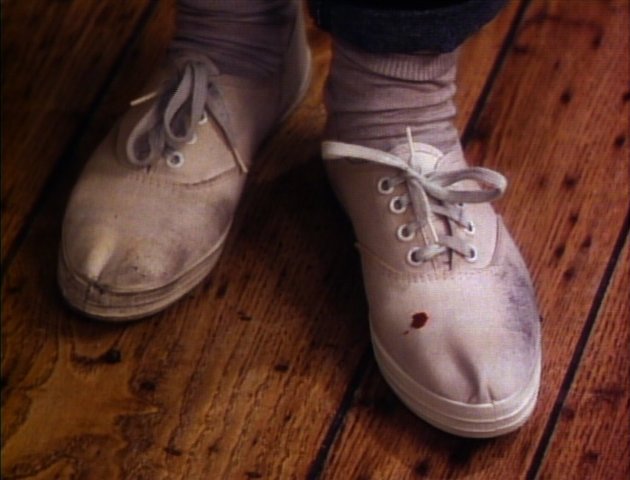Directed by Tom Savini.
Written by Michael McDowell.
Starring Fritz Weaver (Dr. Fenner), Roberta Weiss (Gail Aynsley).
SYNOPSIS: With exams coming up and a shortage of available room and board, student Gail Aynsley resorts to renting out a humble space from veterinarian Dr. Fenner. He’s a bit of a stiff, and the small closet in the bedroom that always remains locked can’t help but pique the girl’s interest. Far less interesting and more terrifying are the weird scratching noises she hears in the dead of night and the unshakable feeling that something is lurking within the walls of the old house.
CRITIQUE: We can sit here all day and talk about the intelligent commentaries that some of these episodes bring up, but nothing quite stays with you like a nice, solid punch to the gut. We always remember the things that have some kind of emotional attachment to them, whether it be love or sadness or joy. Our minds may crave cerebral caviar, but our guts cry out for the greasy shock and the instant satisfaction it brings. With horror though, that satisfaction is more than likely to come in the form of a cold weight in the pit of the stomach than any sense of warm contentment.
“Inside the Closet” remains so memorable to fans of the show because it fulfills this hunger. It can be enjoyed without paying any mind to subtext or metaphor or whatever other academic term you want to throw in there but that is not to suggest that it is lacking in any of these areas; we’ll get to that in a minute. The episode functions primarily as a ghost story, a campfire tale, a shudder yarn. Its design is to prey upon our terrors of the dark and the unknown and make us feel uneasy for a little while. When the question of just what is inside the closet is revealed by the shaking beam of a flashlight, all that’s missing is a big, loud “BOO.”
Roberta, I love you even with the eyebrows. Hell, I love you because of the eyebrows.
Tom Savini, renowned for his makeup effects for such genre efforts as DAWN OF THE DEAD (1978) and MANIAC (1980), takes his first stab at directing and shows that he has a steady hand and keen eye for imagery. He frames the characters in some modestly innovative ways that subtly add to the tension between Gail and Fenner, such as when the doctor speaks directly to the camera, the lens slowly dipping down and angling up to give us the impression that we’re looking up at the domineering medico or the slow pan away from Gail as she desperately tries to explain her apprehension, moving further back from her as Fenner derisively shoots her theories down, isolating her.
The episode is really a small masterpiece of camerawork, not even mentioning the suspenseful POV shots that we get as the closet creature scampers across the bedroom and ducks under the bed. This leads to another moment of repressed kinder-horror: the thought that the beastie under the bed will grab you by the foot if you’re foolish enough to dangle it over the edge like a tasty bit of bait. Gail misses out on realizing this phobia, but only just. There’s another nice touch when we see slides of Bosch’s paintings of Hell that Gail is viewing. The snap of one of her mouse traps sounding off in the closet gives her pause and her panting shadow is cast over the two-dimensional tortures. She knows she’s about to come face-to-face with her own denizen of the inferno.
One of the smaller details that I enjoyed and was only able to glean after several viewings was the décor of Fenner’s house. His main foyer and living room are bedecked with stuffed animal heads and skulls, their gleaming ivory fangs pointing us to the eventual reveal of that which slumbers in the crawlspace of the house. McDowell ends the story on a sardonic note that brings it all back to his original premise: as kids we were scared of the closet, but did we ever think that what was inside was another child all along? For the albino, scarlet-eyed biter that snatches Gail away for private playtime is none other than Fenner’s own daughter, the monstrous offspring of his late wife. When we see her cuddle up on her daddy’s leg, it seems like it’s meant to be comforting in an “Aww, the monster wasn’t so bad all along” way. But it’s not. It’s actually very perverse. I’d like to think that McDowell knew that.
This was another aspect of “Inside the Closet” that caught my attention on the last viewing. Fenner describes his wife’s passing from malignant cancer, detailing the futile operations that she underwent in the process. Are we to assume that Lizzie—as the lovely creature is so-called outside the narrative of the actual episode—was mutated as a result of her mother’s tumor-riddled body? And just when was Lizzie born anyway? Could it have been through a post-mortem Caesarian? And is it an accident that Fenner is, of all things, a veterinarian?
It may be a bit of stretch to assume that the doctor had some kind of animalistic coupling, but that’s what I love about McDowell’s story. The questions are still there. We turn them over in our heads as we lie in bed, trying to tell ourselves that the open closet across the room is really nothing to be afraid of.
“There are no rats in this house.”
***
Rating: 4 Lizzies (But she's biased)
Coming Up: Bruce Davison is looking for happiness in all the write places in "The Word Processor of the Gods."









No comments:
Post a Comment